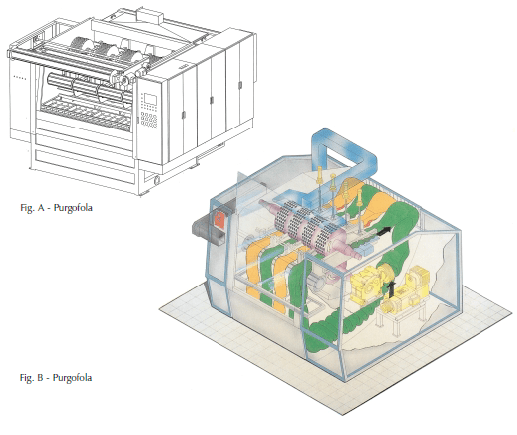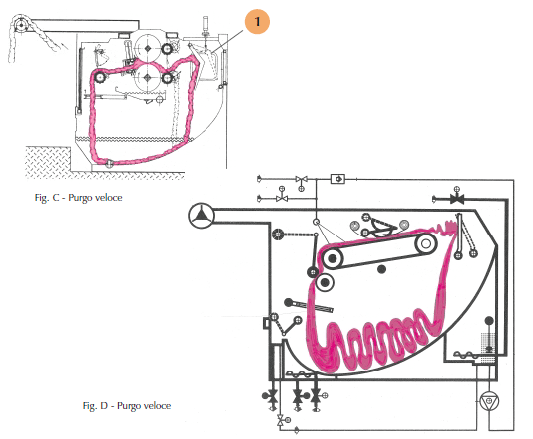© 2025 All rights reserved
Project by UsedTextilemachines.eu
Don't have an account yet? Sign in
Do you already have an account? Go to login Click here
Don't have an account yet? Sign in
Do you already have an account? Go to login Click here
We are happy to assist you
Looking for the best opportunities to satisfy the customer:
Mobile Phone : +393319020189
Working hours: 09.30 / 12.30 - 16.00/18.00 From Monday to Friday.
This process has the purpose of fulling and washing in a single machine - called purgofola -
more pieces (from 4 to 8), inserted into 2 or 4 fulling groups. The basic concepts of the two processes are the same
addressed in the sheets of the two processes (see: fulling and washing).
The entire purging machine (see figures A and B) is made of stainless steel and is automated
to guarantee greater productivity, increasing the cost-effectiveness and cleanliness of the processes.
To treat fabrics that require different fulling percentages for each case in a different way
Fulling has independent controls, with automated management of the entire process.
By excluding the pressure of the slipper, only the purging operation is obtained.
The program panel allows constant control and optimal treatment of the pieces being processed.
The person in charge of processing must adopt a behavior similar to that indicated for the process
of fulling and for washing on the rope.

The quick purge (see figures C and D) is a wash similar to the rope purge but carried out
with measures that increase the working speed and avoid the formation of dead creases.
It is suitable for both carded and combed fabrics.
To obtain even a slight feathering and a fuller hand of the fabric, this process provides
the flapping of the pieces on a special plate located inside the rear wall
of the tank (see figure C, point 1).
The elements that differentiate this process from a normal rope wash are:
the working speed;
the metal plate for flapping the pieces;
the different systems for dragging the piece, such as conveyor belts instead of cylinders
squeezers, for the treatment of different types and qualities of fabrics.

Washing and desizing, which have the aim of removing all impurities from the fabric (sizes,
textile oils or dirt, also resulting from previous processes), can be carried out in
three ways:
to. rope washing (for heavy fabrics, mainly carded);
b. wide wash (for light, delicate, combed fabrics, etc.);
c. continuous washing (wide for large productions).
However, the washing process consists of four subsequent phases:
1. Soaking
The fabric is soaked in water and a mechanical rubbing action eliminates the substances
insoluble, such as earth, dust and unfixed dyes, etc.
2. Prewash
Cold wash, light and fast, which eliminates excess color and dirt that could
fix on the piece in the subsequent degreasing phase.
3. Degreasing
A water bath containing soaps, detergents and auxiliary products, in which the
oiling substances used in spinning and any sizing, oily stains, etc.
The temperature of the bath is fundamental, as it varies in relation to the impurities and components to be eliminated
(from 20° C to 60° C).
4. Rinse
The emulsion with all the substances to be removed is removed with plenty of water.
After the sale of the machinery, we also assist you in logistics and, if desired by the customer, we have technicians capable of reassembling and starting up the machinery.
© 2025 All rights reserved
Project by UsedTextilemachines.eu
| Cookie | Durata | Descrizione |
|---|---|---|
| cookielawinfo-checkbox-analytics | 11 months | This cookie is set by the GDPR Cookie Consent plugin. The cookie is used to store the user consent for the cookies in the "Analytics" category. |
| cookielawinfo-checkbox-functional | 11 months | The cookie is set by GDPR cookie consent to record the user consent for the cookies in the category "Functional". |
| cookielawinfo-checkbox-necessary | 11 months | This cookie is set by the GDPR Cookie Consent plugin. The cookies is used to store the user consent for the cookies in the category "Necessary". |
| cookielawinfo-checkbox-others | 11 months | This cookie is set by the GDPR Cookie Consent plugin. The cookie is used to store the user consent for the cookies in the category "Other. |
| cookielawinfo-checkbox-performance | 11 months | This cookie is set by the GDPR Cookie Consent plugin. The cookie is used to store the user consent for the cookies in the "Performance" category. |
| viewed_cookie_policy | 11 months | The cookie is set by the GDPR Cookie Consent plugin and is used to store whether or not user has consented to the use of cookies. It does not store any personal data. |
Fill out the form to contact me